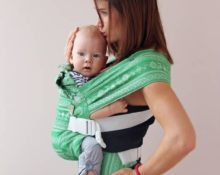With the arrival of a child in the family, a woman has a strong feeling of lack of hands. A restless baby wants to be held in his arms, and not lie quietly in a crib or stroller. And then a sling comes to the aid of a young mother.
Sling scarf for newborns
Sling (from English - sling) - a simple fabric structure for carrying children from the beginning of life to the age when the need to hold the child for a long time passes.
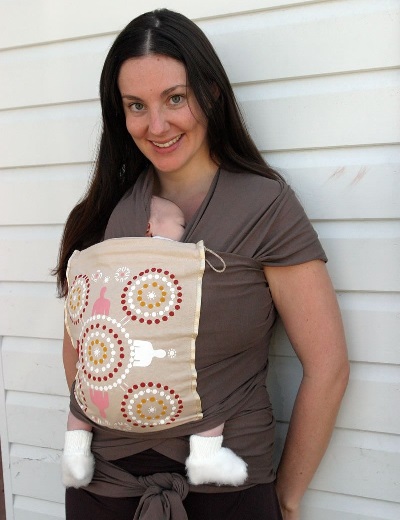
There are several types:
- scarf;
- with rings;
- pocket or pipe;
- May;
- Ombuhimo.
The sling scarf is the most versatile of all. You can put or sit a child in it in different ways of any age.. The position of the baby can be adjusted up to a centimeter.
A scarf is a long material that is tied around an adult in a special way. The baby is seated or placed in the resulting pocket.
The sling supports the baby, freeing the mother's hands.Moreover, when wearing it, the load is distributed over the shoulders, back and lower back, allowing you to not feel discomfort for a long time. At this time, the child is in a comfortable physiological position, without experiencing stress on the spine and joints.
For parents of twins, a sling scarf will be a real salvation.
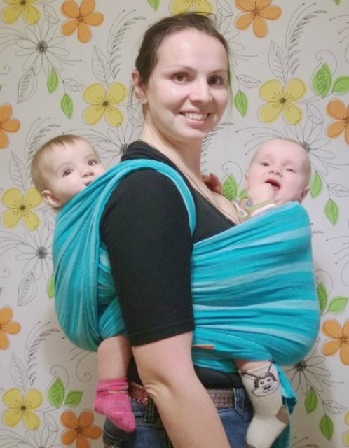
You can purchase a sling scarf at a baby store or wrap it yourself. There are many videos on this topic on the Internet, and here are clear and simple instructions.
To do this, you will need a piece of fabric of double diagonal, diamond and jacquard weave (so that it does not stretch along the length) 60–70 centimeters wide and from 250 to 600 centimeters in length (depending on the parameters of the adult and baby, and the tying method used).
Materials suitable for sling scarf:
- cotton;
- cotton with the addition of silk or bamboo;
- linen with the addition of bamboo.
In order not to make a mistake in choosing a suitable scarf, you must first figure out how to tie it.
Ways to tie a sling scarf
A baby wrapped in a sling can be positioned horizontally or vertically. Moreover, it can be in a sitting position from birth. This is possible thanks to the tight tying of the baby to the adult. The scarf gives the newborn's spine, hip joints and head the same support as a mother's hands.
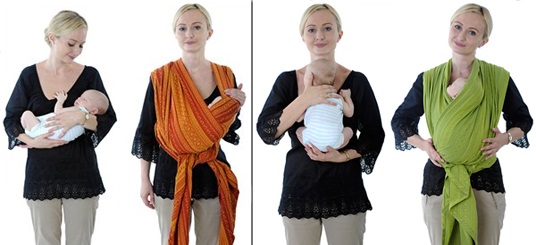
In addition, you can select the child’s location:
- front;
- behind;
- side;
- on the shoulder.
The first method is used from the first days, the others - after 6 months. For each, there are several options for how to wind. At first glance they seem complicated. However, with a little practice following the instructions, it won’t be difficult to properly wrap the baby in one minute.
Cross-cradle
The “Cross-cradle” winding is convenient because the baby can be completely hidden from prying eyes and breastfed. The load is distributed over both shoulders of the parent. The winding is symmetrical; the baby can be positioned with its head to the right or left.
ATTENTION! In the cradle, the baby lies facing his mother. When reeling in this position, you need to make sure that your chin does not touch your chest. This is fraught with asphyxia.
Babies are placed in the cross cradle from birth.
To wind a cross cradle, follow these steps:
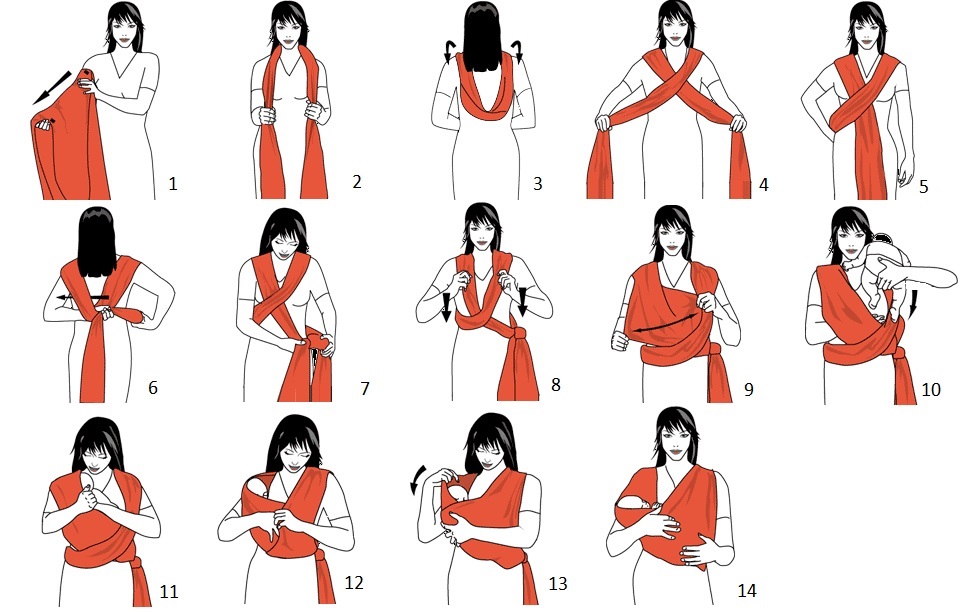
- Fold the fabric in half widthwise. You can fold the sling not along its entire length, but only in its central part.
- Hang the scarf around your neck, making one free edge longer than the other by arm's length from fingers to elbow. There is no need for precise measurements - everything can be adjusted in the future.
- Lower the sling slightly from behind. You need to lower it to the level where your hand can reach for further manipulation.
- Cross the overhanging edges in front of you. The inner edge should be the one towards which the baby's head will be directed.
- Place the extended edge behind your back.
- Pass through the plumb line from behind.
- Pull it out from the opposite side and tie the edges with a double knot. While you have little winding experience, you can tie one knot first. After adjustment, tie the second one.
- Pull up the resulting harnesses and adjust their length. They should not fit too tightly, but not sag too much. Move the node back.
- Stretch the inner harness. The fewer folds there are, the more comfortable the baby will be.
- Holding the baby on the shoulder with one hand from the side of the still assembled harness, stick your other hand inside the straightened one.
- Place the baby in the inner strap, straightening it with both hands.
- Holding the baby with your hand, unfold the second harness of the cross.
- Lower the sling with the baby's head lower down the shoulder so that his face is opposite the chest.
This winding requires a scarf of at least 420 centimeters.
Cross over pocket
An option for tying, also used from the very beginning of life, is the “Cross over the pocket” (aka “Cross with a wrap inside”). It is also performed on two shoulders, but the baby is positioned not horizontally, but vertically.
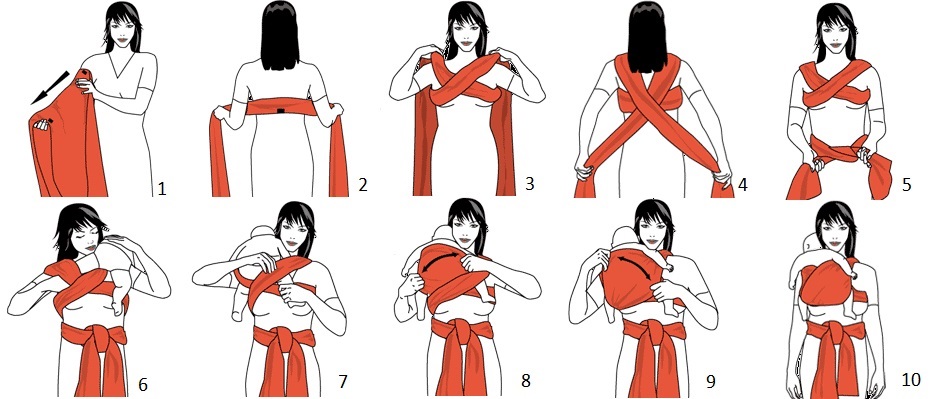
Winding is easy:
- Fold the fabric in half widthwise.
- Find the middle of the length and apply it to your stomach.
- Bringing the edges behind your back, cross them and bring them out in front of you over your shoulders.
- Open the pocket at the front.
- Take the baby on your shoulder.
- Place the baby in the pocket, helping from the inside with your free hand.
- Lay out the pocket, the top edge reached the baby’s shoulder blades, and the second - to the knees. The child should sit so that he hugs the adult with his legs.
- Pull one free edge, holding the baby with one hand.
- Without letting go of the pulled end, hold the baby with this hand. With your other hand, pull up the free end. As a result, the baby should press closely to the stomach. The top edge of the pocket should remain in place.
- Pass the free edges under the baby's knees crosswise. At the same time, the baby should not sag or move anywhere.
- Tie the edges at the back with a straight knot.
- Straighten the inner harness over the child's back
- Straighten the outer harness. The harnesses should straighten out as much as possible without wrinkles from one knee to the other.
- For babies under 6 months, straighten the harness so that the neck is covered and the head is supported.
- Children who can confidently hold their head can lower the pocket and use it with free arms.
The minimum length of the scarf is 420 centimeters.
Cross on the shoulder
The “Cross on the shoulder” winding is used while the baby does not weigh much. With this winding, the baby is positioned in a column, which is useful after eating.

Winding is done simply, without causing any particular difficulties:
- Fold the fabric in half widthwise.
- Find the middle length and place it between the shoulder blades to the back.
- Bring the free edges in front of you, cross them at the height of the diaphragm and throw them over your shoulders.
- Cross the edges at the back, bringing them down to the waist.
- Bring the hanging edges forward and tie a double knot.
- Holding the baby on your shoulder with the outer harness, put one of his legs in the inner harness, helping with your free hand from the inside.
- While holding the baby, insert his other leg into the outer harness.
- Unfold the inner harness.
- Unfold the outer harness.
- The baby was securely secured on the shoulder.
The length of the scarf must be no shorter than 350 centimeters.
Kangaroo on the hip
You can wrap your baby on the side when there is no need to support his head. There are several options for wrapping on the side, for example, “Kangaroo on the hip”. In this option, one harness is made. The child balances while on the other side of the harness, and the center of gravity does not shift.
Winding should be done this way:
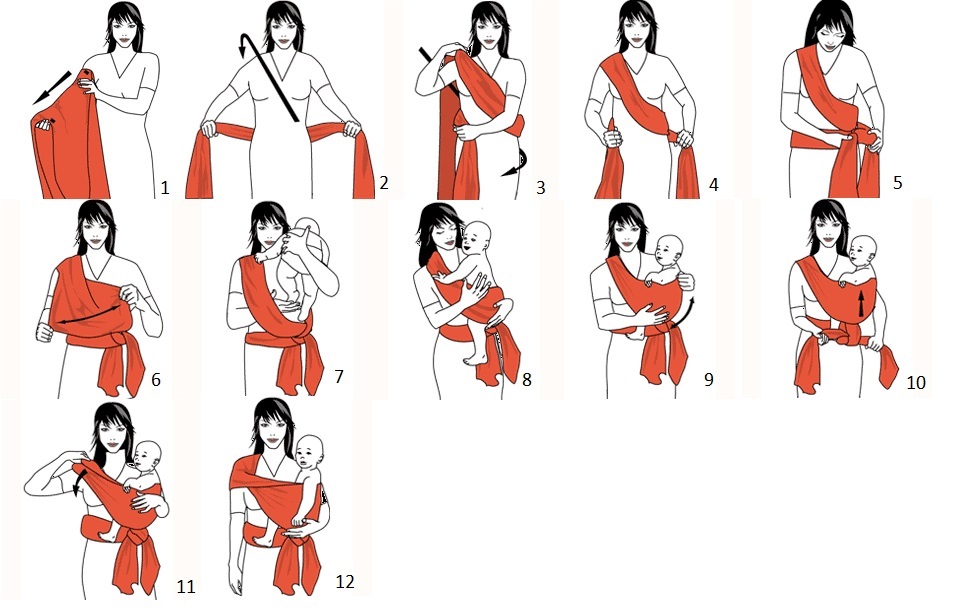
- Fold the fabric in half widthwise.
- Place it on the back of your lower back so that one edge is shorter than the other by the length of your arm to the elbow.
- Wrap the extended edge crosswise over your shoulder and bring it in front of you.
- Level the edges.
- Tie the edges with one knot.
- Lay out the scarf in front.
- From a position on the shoulder, place the baby in the pocket, helping with your free hand from the inside.
- Place the baby on the belt, put his legs in the correct position around the waist.
- Stretch the harness from the baby's shoulder blades to the knees.
- Without untying the knot, adjust the sling's tension and tie a second knot.
- Fold the edge of the harness closer to the neck and lower it a little so that the main part of the fabric remains in the harness. You can wrap it both outward and inward.
This method can be used to wrap a scarf longer than 350 centimeters.
Backpack
For long walks or housework, the “Backpack” winding is suitable. It is designed for children who can hold their head confidently.
Back wraps differ from others in that the child is first wrapped in a sling, given the correct position, and then the scarf is wrapped around an adult.
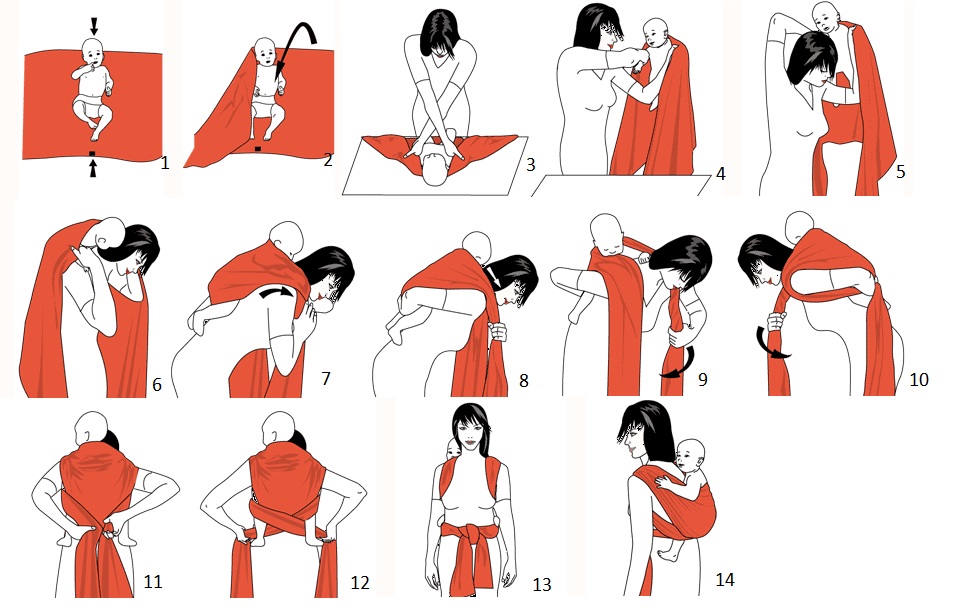
This is done like this:
- In the middle of the laid out canvas, lay the baby across so that the head protrudes slightly beyond the top edge.
- Fold the top edge with the corners, covering the child’s hands.
- With crossed arms, take the baby by the arms at the base, holding the canvas.
- Raise.
- Place the baby behind your back and over your side.
- Leaning forward slightly, place the baby on his back.
- Move the hanging edges over the shoulders and pull them so that the baby is fixed.
- While pulling the two hanging edges of the fabric with one hand, with the other, place the child’s legs in the correct position of hugging an adult.
- Supporting the baby with your hand, make a tourniquet at shoulder level from one edge of the scarf.
- Pass the tourniquet down the back under the baby’s bottom. Change hands. Twist the second strand.
- This tourniquet is also passed on the back, like the first one.
- Cross the two edges under the baby's bottom. Having passed them under the baby’s knees on the adult’s side, bring them out in front of you.
- Straighten up and tie the edges with a double knot at the waist.
Such winding will require a sheet of at least 350 centimeters in length.
Rules for using sling scarves
If the sling is well wound, it is comfortable for both mother and baby.Then wearing it is safe for both and gives the joy of communicating with each other.
IMPORTANT! If even one mistake is made, the whole meaning of the sling as a mother’s assistant is lost.
Main mistakes when using a sling:
- incorrect position of the child;
- incorrect clothing;
- failure to comply with precautions.
Correct position in the sling
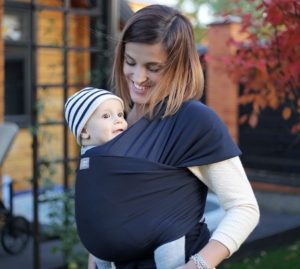
The position of the baby in a sling scarf is of great importance for safety and convenience.
If it is tied too low:
- the center of gravity will shift - balance will be disrupted;
- The baby will not be able to breastfeed.
If your baby sits too high:
- the center of gravity will shift;
- the child will block the view.
If the baby's legs are in the wrong position:
- the legs will interfere with an adult’s walking;
- pressure will be put on the baby's spine;
- the function of preventing hip dysplasia will be lost.
If the scarf is poorly laid out and stretched:
- the baby will sag;
- harnesses will cause discomfort to an adult: they will press hard, rub;
- It will appear that the baby is falling out.
To eliminate these shortcomings, you will have to rewind the scarf.
The baby is positioned correctly if:
- The baby's face is visible to an adult.
- An adult can kiss a baby sitting in a sling on the forehead or the back of the head.
- A lying baby's head is opposite the adult's chest (if necessary, the mother breastfeeds just like that).
- A lying baby's chin does not touch his chest.
- The baby's back is slightly rounded, the pelvis is lowered.
- The knees are spread as wide as possible, the baby clasps the adult with his legs.
- The baby's knees are located above the butt.
- The scarf is straightened, without folds, well stretched. The tension is not too strong (the child may suffocate) and not too weak (the child may move or fall out).
Babywearing clothes
Even when positioned correctly, the baby may still experience discomfort due to incorrect clothing.
When placing a child in a sling, you should not put him in onesies. It is better to choose soft pants that will not interfere with spreading your knees to the sides. Also, do not dress your baby too warmly. This may cause the baby to overheat.
For walks, it is better to use special adult sling jackets or sweaters that are worn over the sling.
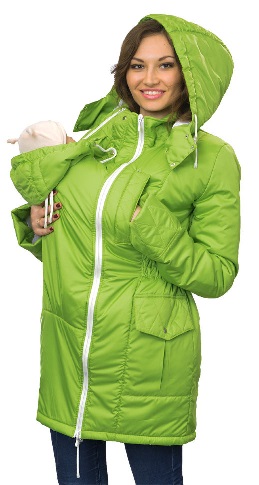
Also suitable are items for pregnant women or just a slightly larger size.
It is worth remembering that a child is pressed tightly against an adult’s clothing, so it should be without small parts, clean, pleasant to the touch, not scratchy and made of natural hypoallergenic fabrics.
Precautionary measures
When using a sling, you must adhere to a series of rules to protect your baby from danger:
- do not cover the baby’s face;
- do not make sudden movements or bends;
- do not allow potentially dangerous things within the child’s reach;
- do not use a sling instead of a car seat;
- do not drink hot drinks when the baby is in a sling;
- do not wear uncomfortable shoes or high-heeled shoes;
- do not forget about the child when opening doors, passing through doorways and turning corners;
- do not run around with a strapped baby without special care;
- do not insist on a sling if the baby protests;
- Don’t forget to consult with your pediatrician about the possibility of using a sling if there are any abnormalities in the child’s physical health.
Learning how to wrap a sling scarf correctly seems like a difficult task. And sometimes there is a temptation to choose a different type of sling, one that is easier to use. However, when choosing, it is worth considering that it is by winding the sling scarf that the tension in each centimeter of the fabric supporting the child is regulated.


 0
0




